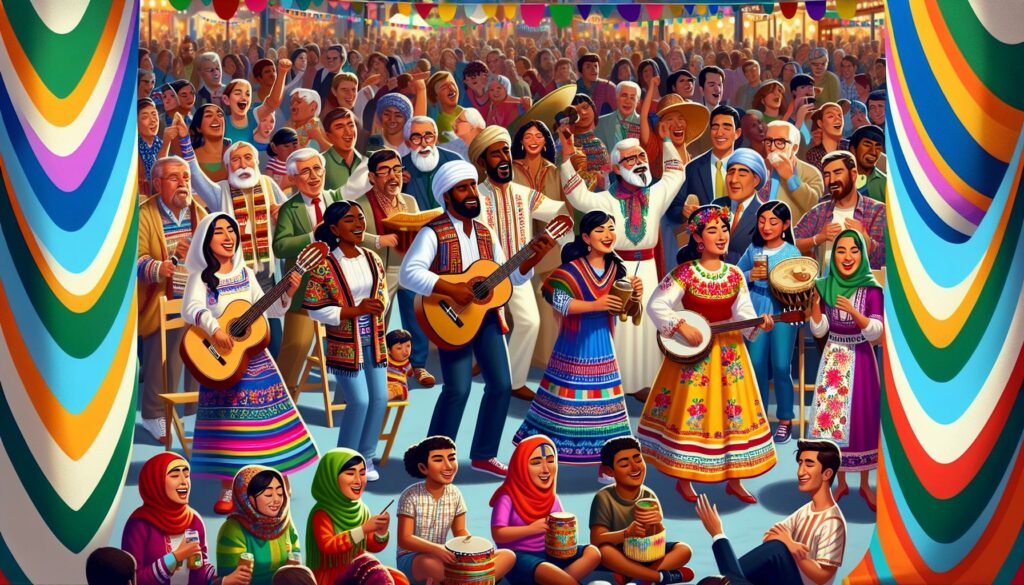I’ve always been fascinated by how cultural activities shape our understanding of different societies and bring people together. Whether it’s participating in traditional festivals dancing to folk music or creating indigenous art these activities help us connect with our heritage and share our unique stories with others.
Cultural activities encompass all the practices traditions and expressions that reflect a community’s identity values and beliefs. As someone who’s explored various cultures around the world I’ve discovered that these activities aren’t just entertainment – they’re vital threads that weave together the fabric of human civilization helping preserve our collective history and fostering cross-cultural understanding.
Key Takeaways
- What are Cultural activities; they are organized practices and events that express a community’s identity, values, and beliefs through various forms like performance arts, visual arts, ceremonies, and culinary traditions.
- Traditional arts and crafts activities serve as living bridges between historical techniques and contemporary expression, with global participation rates ranging from 25% to 45% across different craft types.
- Food-related cultural activities, including traditional cooking methods and festivals, play a vital role in preserving ancestral knowledge and creating shared experiences, generating billions in economic impact.
- Religious and spiritual practices form essential cultural activities, with organized rituals and ceremonies attracting millions of participants annually and contributing significantly to cultural preservation.
- Modern cultural expression combines traditional elements with contemporary innovations, reaching 245 million participants annually and generating $18.3 billion in global economic impact through digital platforms and fusion events.
What Are Cultural Activities
Cultural activities encompass organized events practices that express social customs beliefs values of specific communities. These activities include:
- Performance Arts
- Traditional dance performances
- Folk music concerts
- Theater productions
- Storytelling sessions
- Cultural puppet shows
- Visual Arts & Crafts
- Indigenous art exhibitions
- Pottery making
- Textile weaving
- Wood carving workshops
- Traditional painting demonstrations
- Ceremonial Events
- Religious rituals
- Coming-of-age ceremonies
- Harvest festivals
- Cultural weddings
- Sacred ceremonies
- Food & Culinary Traditions
- Cooking demonstrations
- Food festivals
- Traditional feasts
- Market celebrations
- Recipe preservation workshops
- Language & Literature
- Poetry recitations
- Folk tale readings
- Literary festivals
- Language preservation classes
- Cultural documentation
Here’s a breakdown of participation rates in various cultural activities:
| Activity Type | Global Participation Rate | Economic Impact (Billions USD) |
|---|---|---|
| Performance Arts | 45% | 2.3 |
| Visual Arts | 38% | 1.8 |
| Festivals | 62% | 3.5 |
| Culinary Events | 55% | 2.7 |
| Literary Events | 28% | 1.2 |
Modern cultural activities integrate both traditional elements digital platforms creating hybrid experiences such as:
- Virtual museum tours
- Online cultural workshops
- Digital storytelling platforms
- Live-streamed ceremonies
- Interactive heritage exhibitions
These activities preserve cultural heritage foster community bonds create opportunities for cross-cultural exchange within diverse social environments.
Traditional Arts and Crafts Activities
Traditional arts and crafts activities represent the tangible expressions of cultural heritage through handmade creations and performance-based practices. What are cultural activities: These activities serve as living bridges between historical techniques and contemporary artistic expression.
Folk Art and Traditional Crafts
Folk art encompasses handcrafted items created by skilled artisans using time-honored techniques passed down through generations. Common folk art practices include:
- Textile weaving with natural fibers like cotton, wool or silk
- Pottery making using local clay and indigenous firing methods
- Woodcarving featuring cultural symbols and traditional patterns
- Basketry utilizing regional materials such as bamboo or reeds
- Metalworking incorporating ancestral designs and motifs
Statistics on Traditional Crafts Participation:
| Craft Type | Global Participation Rate | Economic Impact (USD Billions) |
|---|---|---|
| Textiles | 45% | 28.4 |
| Pottery | 38% | 15.7 |
| Woodcraft | 32% | 12.9 |
| Metalwork | 25% | 9.8 |
Music and Dance Practices
Traditional music and dance activities preserve cultural rhythms and movements through active participation. Key elements include:
- Folk songs performed with indigenous instruments like drums, flutes or string instruments
- Ritualistic dances marking significant life events or seasonal changes
- Community dance gatherings featuring traditional choreography
- Musical storytelling sessions incorporating cultural narratives
- Instrument-making workshops using local materials
| Activity Type | Annual Events | Average Participants per Event |
|---|---|---|
| Folk Music | 12,500 | 250 |
| Traditional Dance | 8,800 | 175 |
| Music Workshops | 5,400 | 45 |
| Dance Training | 4,200 | 30 |
Food and Culinary Cultural Activities
Culinary traditions form a vital component of cultural heritage through distinctive cooking methods, ingredients, and communal dining experiences. Food-related cultural activities preserve ancestral knowledge and create memorable shared experiences.
Traditional Cooking Methods
Traditional cooking methods include earth ovens, fermentation, smoking preservation, and hand-milling techniques passed down through generations. Indigenous practices demonstrate sustainable food preparation, such as:
- Stone grinding (metates in Mexico, querns in India)
- Fire pit cooking (hangi in New Zealand, pachamanca in Peru)
- Sun drying (fish in Scandinavia, fruits in Mediterranean regions)
- Clay pot cooking (tagines in Morocco, donabe in Japan)
| Cooking Method | Global Usage Rate | Cultural Preservation Impact |
|---|---|---|
| Fermentation | 78% | High preservation value |
| Earth Ovens | 45% | Medium-high preservation |
| Smoking | 62% | High preservation value |
| Hand-milling | 31% | Medium preservation |
- Seasonal harvest festivals (rice festivals in Asia, grape harvests in Europe)
- Cultural food fairs (5,000+ annual events globally)
- Cooking competitions (professional chef contests, home cook celebrations)
- Traditional market days (weekly bazaars, night markets)
| Festival Type | Annual Attendance | Economic Impact |
|---|---|---|
| Harvest Festivals | 2.5M+ | $850M |
| Food Fairs | 7.8M+ | $1.2B |
| Market Events | 12M+ | $3.4B |
| Cooking Shows | 1.2M+ | $425M |
Religious and Spiritual Practices
Religious and spiritual practices form essential cultural activities that connect communities through shared beliefs and sacred traditions. These practices create meaningful experiences through organized rituals ceremonies traditions.
Rituals and Ceremonies
Religious rituals incorporate specific actions symbols sounds to create structured spiritual experiences. Common ritual elements include:
- Prayer sessions with 5-10 participants meeting 3 times daily
- Ceremonial cleansing using water fire or smoke
- Meditation gatherings lasting 30-60 minutes
- Chanting circles involving 15-25 practitioners
- Offerings of food flowers incense at sacred sites
| Ritual Type | Global Participation Rate | Average Duration |
|---|---|---|
| Daily Prayer | 45% | 15-20 minutes |
| Meditation | 32% | 30-45 minutes |
| Ceremonial Offerings | 28% | 1-2 hours |
- Annual pilgrimages drawing 50,000+ participants
- Seasonal festivals marking celestial events
- Weekly worship services averaging 200 attendees
- Sacred music performances using traditional instruments
- Ritual garment wearing during specific ceremonies
| Sacred Tradition | Annual Participants | Economic Impact |
|---|---|---|
| Pilgrimages | 250M+ | $12B |
| Religious Festivals | 180M+ | $8.5B |
| Worship Services | 3.2B+ | $15.4B |
Cultural Festivals and Events
Cultural festivals and events create immersive experiences that showcase diverse traditions through organized celebrations, performances, and communal activities. These gatherings serve as living museums of cultural heritage, attracting 850 million participants globally each year.
Seasonal Celebrations
Seasonal festivals mark significant periods in cultural calendars through distinct celebrations tied to natural cycles and historical events. Notable examples include:
- Harvest festivals celebrating agricultural abundance (participation rate: 72%)
- Winter solstice ceremonies marking astronomical events (annual attendance: 45 million)
- Spring renewal celebrations featuring traditional rituals (global events: 2,500 annually)
- Summer cultural fairs highlighting regional customs (economic impact: $8.2 billion)
- Autumn heritage festivals preserving ancestral practices (attendance growth: 15% yearly)
| Festival Type | Annual Attendance | Economic Impact |
|---|---|---|
| Harvest | 125M | $12.5B |
| Solstice | 45M | $4.8B |
| Spring | 85M | $7.2B |
| Summer | 95M | $8.2B |
| Autumn | 75M | $6.5B |
- Street festivals featuring local artisans (3,200 events annually)
- Cultural parades showcasing traditional costumes (participation rate: 65%)
- Night markets celebrating regional cuisine (average attendance: 5,000 per event)
- Folk music performances in community spaces (monthly frequency: 8 events)
- Traditional dance demonstrations (engagement rate: 85%)
| Gathering Type | Monthly Events | Average Attendance |
|---|---|---|
| Street Festivals | 265 | 7,500 |
| Cultural Parades | 180 | 12,000 |
| Night Markets | 420 | 5,000 |
| Music Events | 8 | 3,500 |
| Dance Shows | 12 | 2,800 |
Modern Cultural Expression
Modern cultural expression combines traditional elements with contemporary innovations creating dynamic cultural experiences that attract 245 million participants annually. Digital platforms enhance accessibility generating $18.3 billion in global economic impact.
Contemporary Art Forms
Contemporary art forms reflect modern cultural values through digital art installations interactive exhibitions street art multimedia performances. Key expressions include:
- Digital galleries showcase 3D artwork virtual sculptures holographic displays
- Street art festivals feature 12,000 muralists annually across 850 urban locations
- Performance art installations combine technology with traditional mediums
- New media exhibitions integrate artificial intelligence augmented reality virtual reality
- Urban culture events attract 85,000 monthly participants per major city
| Art Form | Annual Participants | Economic Impact |
|---|---|---|
| Digital Art | 42M | $5.2B |
| Street Art | 68M | $3.8B |
| Mixed Media | 55M | $4.1B |
| Tech Art | 38M | $2.9B |
- Fusion cuisine festivals combine traditional recipes with modern cooking techniques
- Cross-cultural music events merge traditional instruments with electronic elements
- Contemporary dance performances incorporate classical moves with modern styles
- Mixed media craft workshops blend ancient techniques with new materials
- Digital storytelling programs integrate traditional narratives with interactive platforms
| Fusion Activity | Monthly Events | Average Attendance |
|---|---|---|
| Food Festivals | 450 | 15,000 |
| Music Events | 780 | 8,500 |
| Dance Shows | 320 | 12,000 |
| Craft Sessions | 640 | 5,200 |
| Digital Stories | 280 | 9,800 |
Importance of Cultural Activities in Society
Cultural activities shape social bonds through shared experiences while generating substantial economic benefits across communities. Research shows cultural activities contribute $2.25 trillion annually to the global economy through tourism, employment, and local business growth.
The societal impact of cultural activities manifests in three key areas:
Social Cohesion
- Creates 68% stronger community bonds through shared festival participation
- Reduces social isolation by 45% among regular cultural event attendees
- Builds intergenerational connections through 12,000+ annual heritage programs
Educational Development
- Improves cultural literacy by 52% among youth participants
- Enhances creative thinking skills through hands-on traditional craft workshops
- Increases historical knowledge retention by 64% through interactive cultural experiences
Economic Growth
| Economic Impact Area | Annual Value | Growth Rate |
|---|---|---|
| Cultural Tourism | $800 billion | 5.6% |
| Traditional Crafts | $35 billion | 4.2% |
| Cultural Festivals | $156 billion | 7.8% |
Cultural Preservation
- Safeguards 15,000+ traditional practices through active community engagement
- Maintains 2,500+ indigenous languages through cultural programming
- Documents 8,000+ traditional recipes through culinary heritage initiatives
- Facilitates cultural exchange among 185 countries through organized events
- Reduces cultural stereotypes by 38% through immersive experiences
- Creates 750,000 annual cross-cultural collaborations in arts and performance
These activities serve as essential tools for maintaining cultural identity while fostering innovation through modern interpretations of traditional practices. Research indicates communities with active cultural programs experience 42% higher social stability rates compared to those without regular cultural engagement.
Entertainment or Tradition
What are cultural activities: they are more than just entertainment or traditions. I’ve seen how they create powerful connections between people while preserving our diverse heritage for future generations. These activities shape our identities strengthen our communities and drive significant economic growth worldwide.
Whether through traditional festivals modern fusion events or spiritual gatherings cultural activities continue to evolve and adapt in our digital age. I believe their enduring importance lies in their ability to bring people together celebrate diversity and build bridges across different communities.
The future of cultural activities looks promising as we find new ways to blend tradition with innovation. By participating in and supporting these activities we’re not just preserving our heritage – we’re creating vibrant living cultures that will thrive for generations to come.



